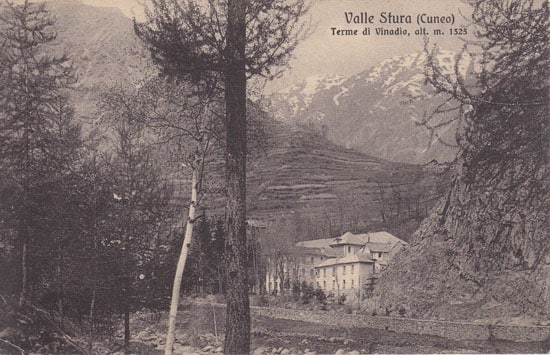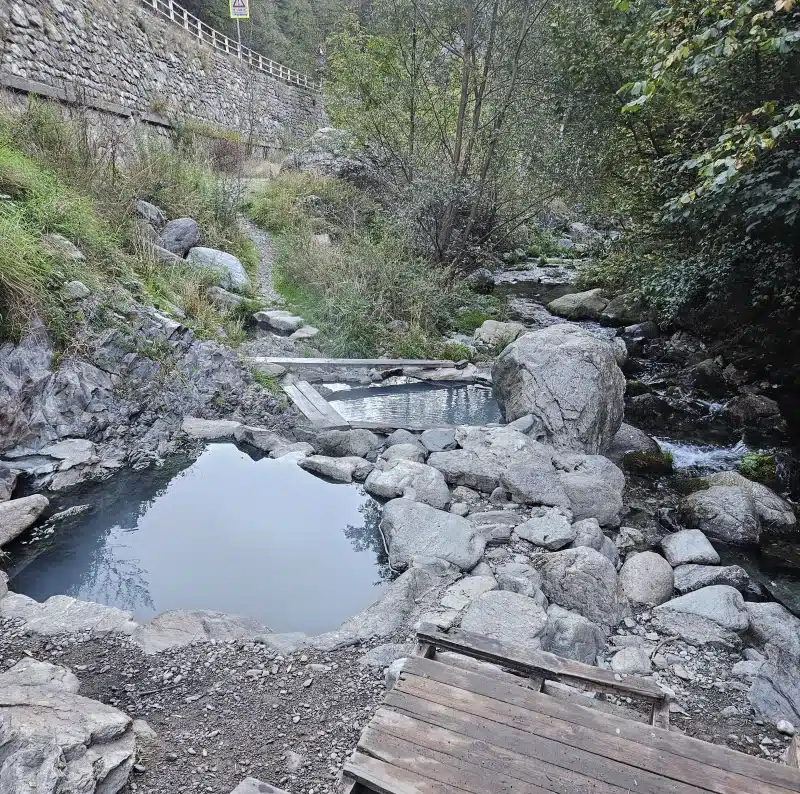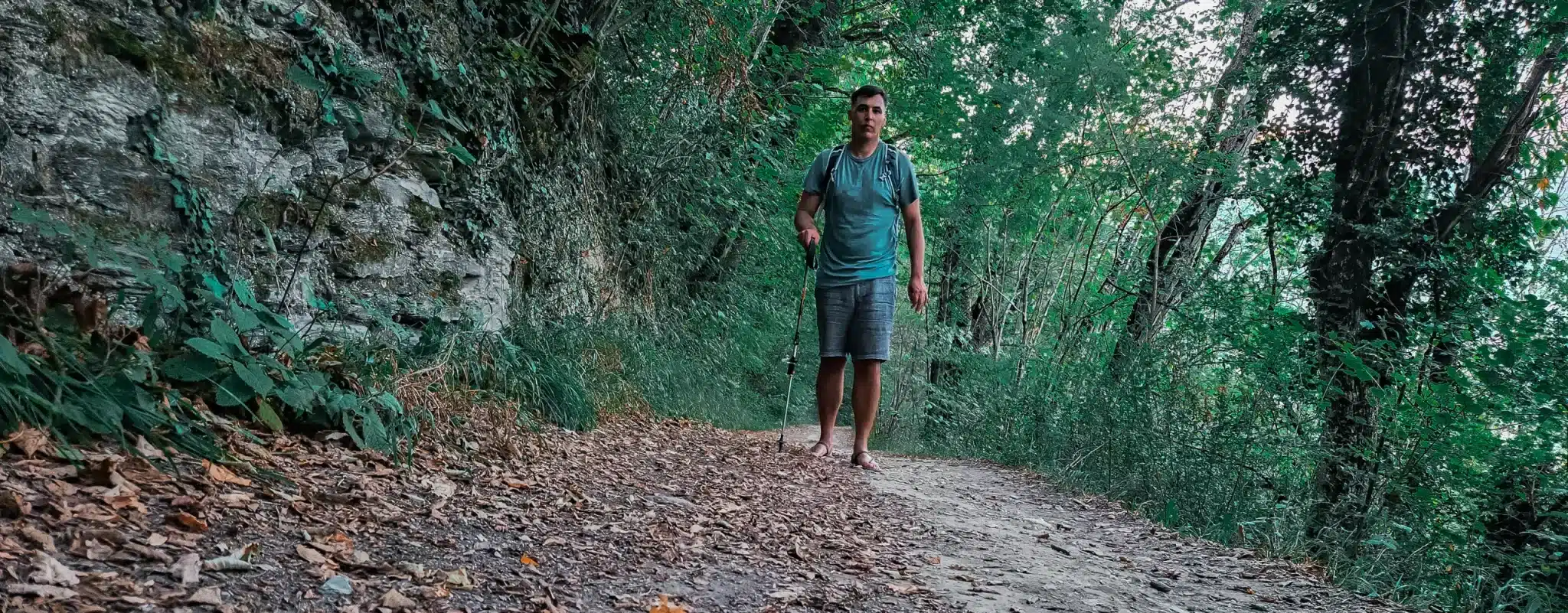Terme di Vinadio: Hot Springs to Visit in Piedmont
- Nature Source Chaude
- Published on
- Updated on 26 June 2025
Most of northern Italy is dominated by the mountain range of the Alps. To the west of this range, many hot springs were once discovered. This is particularly the case in the Piedmont region and, more specifically, in the province of Cuneo.
There is even an incredible place where you can enjoy thermal waters in an exceptional natural setting for free. This place, which I was lucky enough to discover, is located at ‘Bagni di Vinadio’ at an altitude of 1310 metres. Read more about this enchanting place in this article.
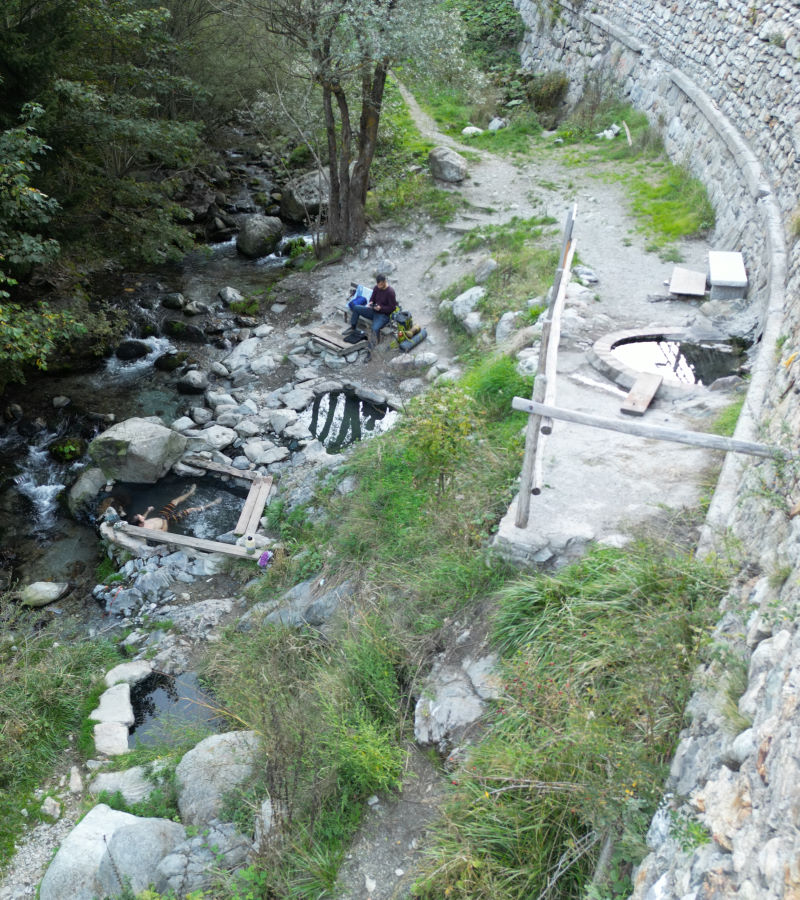
Table of contents
A little bit of the history
Cuneo is the capital of the province of the same name. Built in the Middle Ages (12th century) at the foot of the Alps, it is the gateway to the Mercantour-Argentera crystalline massif, which straddles France, Italy and the Italian region of Piedmont.
This massif has been occupied by man since ancient times, then in the Middle Ages with the salt route. It is also the site of intense seismic activity, which brings thermal waters to the surface. In fact, these hot springs have been known since Roman times, when numerous remains were left. Their points of emergence have not changed since then.
After a long underground journey, the springs come to the surface in two of these valleys: the Gesso Valley (Valdieri) and the San Bernolfo Valley (Bagni di Vinadio). These hot springs are undoubtedly one of the most popular attractions in the province of Cuneo.
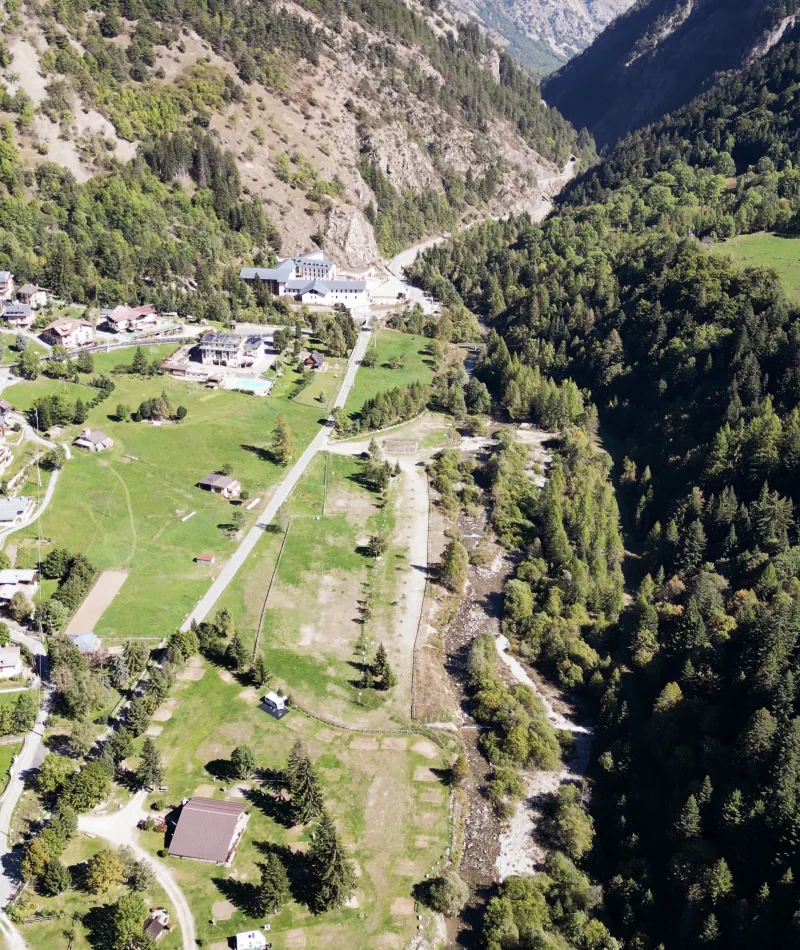
It was very popular in the Middle Ages, and it was not until the middle of the 16th century that a spa centre was built in the upper Gesso Valley, known as the ‘Bains de Vaudier (Valdieri)’, in order to make the most of the hot springs.
The neighbouring valley of San Bernolfo followed the same path, with the construction in the 1700s of a series of buildings known as the ‘Bains de Vinai (Vinadio)’ (buildings with grey roofs in the photo).
Throughout history, wars have often led to new periods of exploitation.
At the beginning of the 19th century, the Sardinian Restoration completely redrew the map of Europe, paving the way for new eras in the exploitation of thermal springs. In the middle of the nineteenth century, the fashion for spa treatments, both in summer and in winter, took off.
English overwinterers, followed by tourists from all over Europe, flocked to the Mediterranean coast, attracted by the mild climate.
The managers of the Vinadio and Valdieri thermal baths worked hard to accommodate these travellers. These thermal baths also enjoyed a good reputation. Located in the south of the States of Savoy, they were frequented by the kings of Piedmont-Sardinia, who loved to stay there.
Terme di Vinadio
Since the 1700s, the Bagni di Vinadio have continued to expand, despite their difficult location in the middle of the mountains. They are located at an altitude of 1,330 metres at the foot of Mount Olive, in the San Bernolfo valley, as shown on other old postcards on the Ubaye en cartes website.
The popularity of the hot springs led to the reconstruction of a building in the mid-18th century to exploit the beneficial properties of the water. Since 2016, the spa centre has been under renovation and is currently closed to the public.
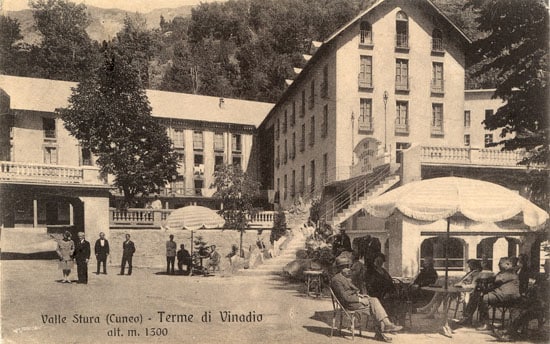
The Terme di Vinadio (Vinadio thermal baths) are home to a number of hot springs, six of which were in use until they were closed. Two of them are in the spa centre itself, while four others are nearby and their water is piped into the centre.
There are also two other hot springs near the centre that have been left in their natural state. These are the free Vinadio Baths.
The natural baths in Bagni di Vinadio
The free baths of Bagni di Vinadio are just opposite the spa centre. A footpath leads from a small car park to the baths.
When you arrive, you will see three small pools in the middle of nature. These were there long before the spa centre was closed.
These free baths have never caused the slightest problem. In fact, it’s the local municipality that looks after them and keeps them clean and in good condition.
The first hot spring is hidden behind a stone wall. But a small pipe brings the hot water from inside the wall. It flows into a small circular pool that can hold two medium-sized adults. The water temperature is 39°C.
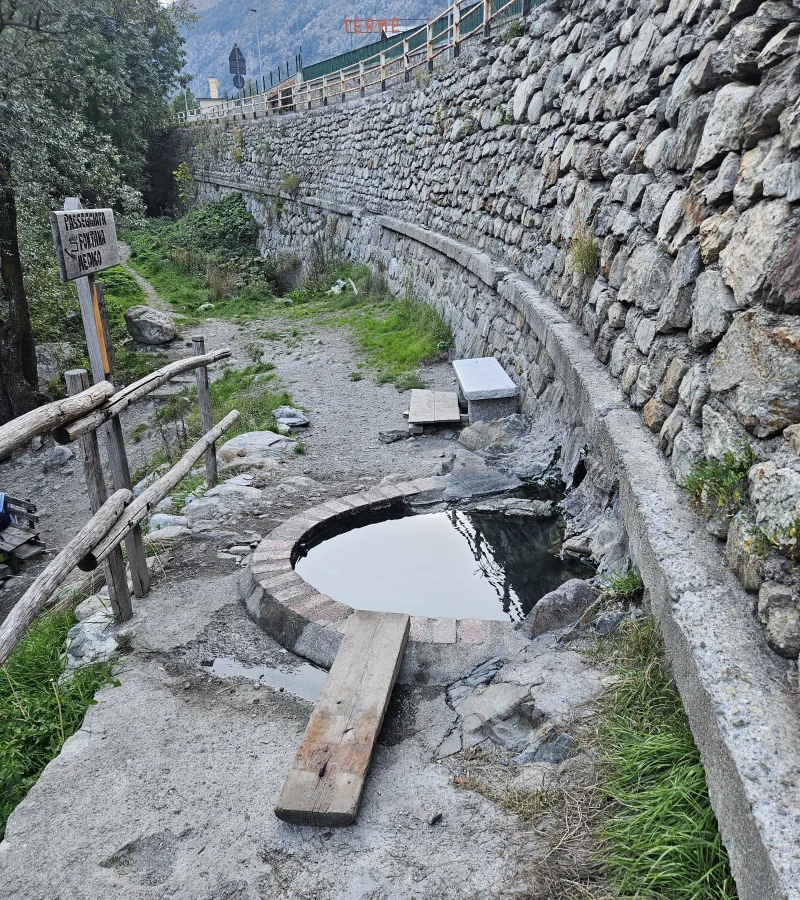
The second hot spring is below. The water gushes out of the rock and flows directly into a pool with a temperature of about 42°C, which can hold four people.
This water then flows into another pool surrounded by planks and topped by a large stone. The temperature is between 34°C and 36°C.
A fourth small pool filled with cold water can also be seen on the site.
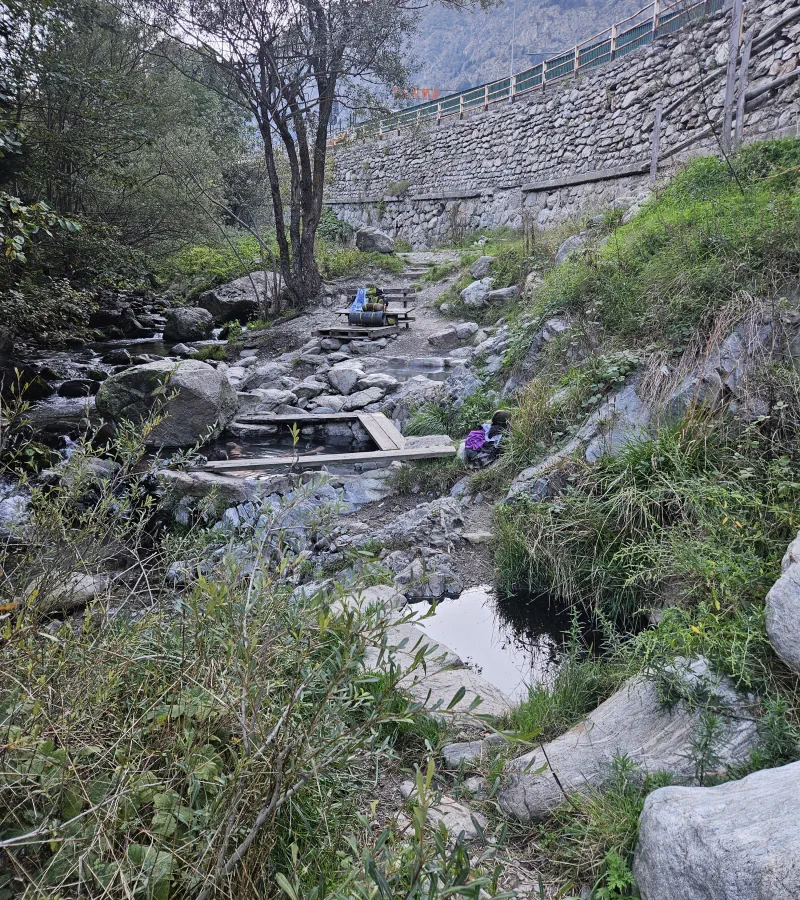
The site is particularly small and can only accommodate about ten people. Despite the proximity of the road (just above), the place is a complete change of scenery. The Corborant stream flows next to the natural pools. Some daredevils alternate between hot and cold baths. The mountain environment is particularly pleasant and gives a real soothing touch.
The nature and therapeutic properties of hot springs
There is every indication that the thermal waters of Vinadio come from a depth of 5 to 6 kilometres, as geothermal studies have shown. The hottest mineral spring has a temperature of 70-75°C. The waters of Vinadio have a high pH, between 8 and 9. The salinity varies (between 0.6 and 2 g/l) according to the springs (there are eight in total).
The unique composition of this water is due to deep infiltration, which leaches out many elements. Sodium, potassium, carbonate, hydrogen carbonate, sulphate, chloride and silica ions are present in significant quantities. These waters therefore belong to the group of sulphurous, sulphate-chloride-sodic and hyperthermal waters (temperature > 50°C).
Sulphurous waters (H₂S) are easily identified by their rotten-egg smell. Their concentration of sulphur (hydrogen sulphide) is close to 8 mg H₂S/l. The waters of the Terme di Vinadio are slightly more sulphurous and mineralised than those of the Terme di Valdieri.
They also contain low levels of calcium ions (less than 70 mg/l) and almost no magnesium ions (less than 1 mg/l). The most important trace elements are lithium and fluoride in ionic form. They are generally beneficial when combined with other minerals.
The therapeutic properties of these waters were already known in Roman times and were described in the 16th century. These sulphurous waters are used to treat ENT, respiratory, cardiovascular, digestive, urinary, hepatic, metabolic, dermatological, rheumatic and musculo-skeletal disorders. They have many virtues.
How do I get to the Bagni di Vinadio hot springs?
Bagni di Vinadio is a hamlet 10 km from Vinadio, the town to which it belongs. No less than 17 hamlets belong to this municipality in the upper Stura Valley.
Thanks to its strategic position, Vinadio is close to the main road of the valley. The city of Cuneo to the east is only 35 km away, while the Larche Pass is about 30 km to the west.
On this main road you will see a sign for ‘Bagni di Vinadio’. The road then enters the San Bernolfo Valley and leads directly to the Bagni di Vinadio thermal baths. The free hot springs are opposite the spa centre, on the other side of the road (see location on our map).
When should you visit Bagni di Vinadio?
Access to the baths is free all year round. The few small shops (restaurants, small grocery) in the valley are mainly open in summer and winter. Most of the shops are closed between the seasons, but it is possible to make reservations at some restaurants.
In winter, even though we’re in a mountainous region at over 1,300 metres, the warm baths are particularly pleasant. In fact, it’s essential to equip your car (with chains or snow tyres) to get there.
Finally, in winter I noticed that the thermal water was slightly mixed with cold surface water. This dilution can reduce the properties of the thermal water. The temperature of the water in the pools can also drop a few degrees. Personally, I prefer to go in spring and autumn, but that’s just a matter of personal preference.


